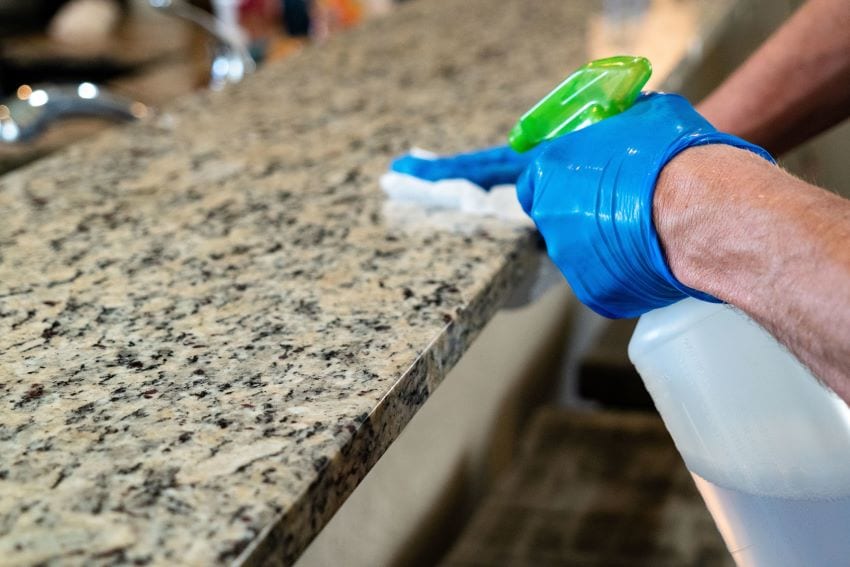
The guidance outlined in the Health Service Act CAP. 44 (Food Hygiene and Restaurant Regulations) is designed to reduce and prevent the incidence of foodborne illness. Regulatory requirements related to sanitation and personal hygiene in particular are the most reliable protocols available to combat risks related to the spread of COVID-19.
The protocols of this document build on these regulations. It is anticipated, that where safe food handling practices are already in place, only minor modifications to the facility and daily practices are needed.
This guidance is designed to provide a basic summary of recommended practices that can be used to help mitigate exposure to the COVID-19 virus, including:
- Food safety
- Cleaning and sanitizing
- Employee health monitoring and personal hygiene
- Physical distancing
As we continue to learn more about operating businesses during the COVID-19 pandemic, it is important to note that best practices may change.
Food Safety
- Clean, wash and sanitize utensils frequently and place appropriate barriers in open areas to reduce the risk of contamination.
- Cafeteria style (worker served) operations is permissible with barriers in place that effectively shield the food from contamination, for example such as covers and plexiglass.
- Where salad bars and buffets are utilized, sneeze guards must be in place.
- Customers must wash or sanitize their hands before going to the salad bar of buffet.
- Avoid using food and beverage containers or utensils brought in by customers.
- Ensure that ventilation systems operate properly and increase circulation of outdoor air as much as possible such as by opening windows and doors. Do not open windows and doors if doing so poses a safety risk to employees, children, or customers.
Cleaning and Sanitizing
- Thoroughly detail-clean and sanitize entire facility, especially if it has been closed. Focus on high-contact areas that would be touched by both employees and guests. Do not overlook seldom-touched surfaces. Follow sanitizing material guidance to ensure it is at effective sanitizing strength and to protect surfaces.
- Wash, rinse and sanitize food contact surfaces, food preparation surfaces, and beverage equipment after use. (Using a food based sanitizer)
- Wherever possible, assign a staff member to work the self-service drink stations and remove unwrapped straws from self-service stations.
- Use disposable foodservice items (utensils, dishes) where appropriate.
- Where possible, a hand sanitizing station for customers should be placed near the salad bar or buffet.
- Make hand sanitizer readily available to guests. Consider touchless hand sanitizing solutions.
- Check restrooms regularly and clean and sanitize them based on frequency of use.
- Where possible, avoid sharing items such as menus and condiments. Use disposable or digital menus; throw away disposable menus after each use. Opt for single use condiments. Where menus are housed in a folder, they must be sanitized after each use.
- Use contactless payment options as much as possible.
- Where possible, appoint an employee to handle cash and payments only. In single-person operations, hand sanitizer should only be used where handwashing facilities are not readily available.
- Use gloves when handling and disposing of trash. Dispose of gloves immediately after and wash hands.
- Clean and sanitize frequently touched surfaces such as the shelves and countertops for grab-n-go food items.

Employee health monitoring and personal hygiene
- Employees who are sick should remain at home.
- Any employee experiencing symptoms of COVID-19, such as fever, cough, shortness of breath or loss of the sense of taste or smell must be excluded from the establishment immediately and sanitation operating procedures (SSOPs) need to be followed strictly. (Close off areas used by a sick person and do not use until the areas have been cleaned, sanitized and, in non-food contact areas, disinfected. If possible wait 24 hours to clean, sanitize and disinfect. If waiting 24 hours is not possible, wait as long as you can. Ensure safe and correct application of disinfectants and keep disinfectant products away from children.)
- An employee absent from work due to suspected COVID-19 symptoms Shall Not return to work unless certified by a Medical Officer of Health.
- Employees must wash hands with soap and water according to the handwashing protocol for 20 seconds at the commencement of work.
- All persons entering the facility for the purposes of work must wash their hands.
- Employees must follow the principles of good hand hygiene throughout the food handling process.
- The taking of employee temperatures is discretionary. However, if temperatures are taken, any person with a temperature over 100.3 degrees F or 38.0 degrees C and above shall not be permitted in the workplace.
- Wherever possible, food handlers should wear face masks during working hours.
- Single use masks must be discarded after each use. Cloth masks must be laundered at the end of each use. No mask must be worn for more than four hours at a time and should be changed if it becomes damp (disposable mask are preferable as their changing can be more easily regulated)
- Observe respiratory hygiene (cover your cough, sneeze and dispose of any tissue used) at all times and wash hands with soap and water.
- Train all employees on the importance of frequent hand washing, the use of hand sanitizers with at least 70% alcohol content, and give them clear instruction to avoid touching hands to face.
- Ensure adequate supplies to support healthy hygiene practices for both employees and customers including soap, hand sanitizer (on every table, if supplies allow), paper towels, and tissues.
- If an employee is at high-risk for severe illness, consider assigning them duties that minimize their contact with customers and other employees. (e.g., managing inventory rather than working as a cashier)
- Inform those who have had close contact to a person diagnosed with COVID-19 to stay home and self-monitor for symptoms. Follow the Ministry of Health and Wellness’ guidance if symptoms develop.
- Establish procedures for safely transporting anyone sick to their home or to a health care facility.
- Immediately notify the Ministry of Health and Wellness of any possible case of COVID-19.

Physical Distancing
- Update floor plans for common dining areas, redesigning seating arrangements to ensure at least six feet of separation between table setups. Where practical, especially in booth seating, physical barriers are acceptable. Consider a reservations-only business model or call-ahead seating to better space diners.
- Provide physical guides, such as tape on floors or sidewalks to ensure that customers remain at least six feet apart in lines or ask customers to wait in their cars or away from the establishment while waiting to dine or pick up food. Post signs to inform customers of food pickup and waiting protocols.
- Any physical distancing measures based on square footage should take into account service areas as well as guest areas.
- All suppliers or delivery personnel should wear masks at the point of delivery
- Employees receiving goods are also required to wear masks.
- Persons receiving goods must wash their hands immediately after receiving goods.
- Delivery personnel must wash or sanitize their hands before and after every delivery.
- Post signage at the entrance that states that no one with a fever or symptoms of COVID-19 is to be permitted in the restaurant.
- Limit contact between food service personnel and guests. Food service personnel should wear face masks (coverings).
- Install physical barriers, such as sneeze guards and partitions at cash registers, bars, host stands, and other areas where maintaining physical distance of six feet is difficult.
- If practical, physical barriers such as partitions or plexiglass barriers at registers are acceptable.
- Use technology solutions where possible to reduce person-to-person interaction: mobile ordering and menu tablets; text on arrival for seating; and contactless payment options. Consider options for dine-in customers to order ahead of time to limit the amount of time spent in the establishment
- Try not to allow guests to congregate in waiting areas or bar areas. Design a process to ensure guests stay separate while waiting to be seated. The process can include floor markings, outdoor distancing, waiting in cars, etc. Consider an exit from the facility separate from the entrance. Determine the entry/exit to and from restrooms to establish paths that mitigate proximity for guests and staff.
- Limit the number of employees allowed simultaneously in break rooms.
You may also download the COVID-19 framework for the recommencement of the restaurant and food services industry in Barbados by clicking here.
